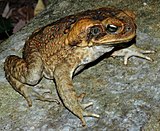Portal:Amphibians and reptiles/Selected article/1
The Cane toad (Bufo marinus), also known as the Giant neotropical toad or Marine toad, is a large, terrestrial true toad native to Central and South America. It is a member of the genus Bufo, which includes hundreds of different true toad species in different habitats throughout the world. The Cane Toad is a prolific breeder; females lay single-clump spawns with large numbers of eggs. Its reproductive success is partly because of opportunistic feeding: it has a diet, unusual among Anurans, of both dead and living matter. Adults average 10 to 15 centimetres (4–6 in) in length; the largest recorded specimen weighed 2.65 kilograms (5.84 lb) and measured 38 centimetres (15 in) from snout to vent.
The Cane toad has large poison glands, and adults and tadpoles are highly toxic to most animals if ingested. Because of its voracious appetite, the Cane toad has been introduced to many regions of the Pacific and the Caribbean islands as a method of agricultural pest control, notably in the case of Australia in 1935, and derives its common name from its use against sugarcane pests. The Cane Toad is now considered a pest in many of its introduced regions, because its toxic skin kills many native predators when ingested. It has many negative effects on farmers because of pets and animals eating the creatures.

